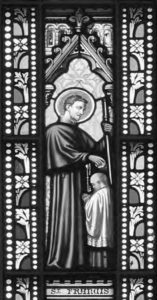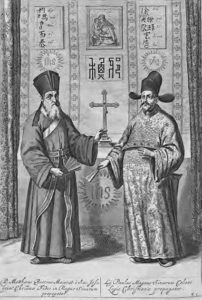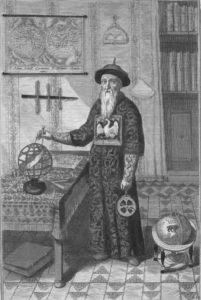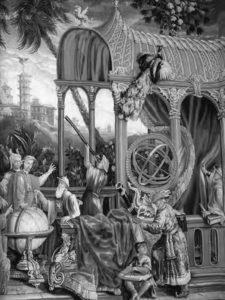
Comparative world and global history topics can add both vibrancy and genuine intellectual depth to secondary school and undergraduate courses. The story of how priests who embraced the concept of contemplatives in action encountered highly educated Chinese Confucian literati is an excellent example of cross-cultural contact. Even beginning to learn about these interactions should lead readers to some realization of the potential creativity, as well as intended and unintended consequences, that come into play when adherents of two different but venerable belief systems make mutual contact.
The Society of Jesus, a Roman Catholic order of priests known as the Jesuits, launched foreign missions shortly after its founding in 1534 by Ignatius of Loyola, a Spanish nobleman-turned-priest. The Jesuit Asian missions were some of the most thoughtful and creative Christian ventures, seeking to adapt Christian faith to local cultures. Jesuits embedded themselves in Asian societies in order to understand them more fully and thus equip themselves with a conceptual and terminological vocabulary necessary for rendering the gospel to native audiences. What followed was a complex, and often-controversial, methodology of missions focused on the engagement between Christianity and culture.
The Spanish Jesuit Francis Xavier, who had toiled on the mission field in India and Japan, was one of the first Jesuits to set foot on Chinese soil in the late Ming dynasty (1368–1644). In 1552, overcome by illness and the logistical nightmare of crossing into China, the famed Jesuit died without seeing his dream of a mission realized. After Xavier’s passing, the Jesuit enterprise in the region stalled for twenty-five years, until the arrival of the Italian priest Michele Ruggieri. Ruggieri came to China as a protégé of Alessandro Valignano, visitor of missions in Asia, who effectively supervised the Jesuit work in East Asia by advocating for a practice of accommodation—a contextualized version of Christianity that aimed to relinquish its European baggage and honor the particulars of local cultures. Under the guidance of Valignano, Ruggieri embarked on the task of learning Mandarin, the language of the literati, the educated elites of China. In time, he was able to befriend Mandarins, officials in the imperial civil service who belonged to the literati class. This small victory would prove instrumental in establishing and maintaining the China mission. In 1583, Ruggieri was joined by Matteo Ricci, another legendary pioneer of the China mission, and the two men would work together for six years in Zhaoqing, in Guangdong Province, immersing themselves in the culture and making modest gains in proselytizing the Chinese.1
With Ruggieri’s departure in 1585, Ricci assumed charge of the China mission. While perfecting his language skills and deepening his knowledge of Confucianism, Ricci developed connections among prominent members of Chinese society. Ricci’s foresight in posing as a Western scholar, capable of engaging Confucian philosophy to underpin his presentation of the gospel, helped the China mission gain credibility with the educated elites. Pursuing a further integration into the elite Chinese circles, Ricci began wearing traditional Mandarin clothing, thus identifying with the literati. The top-down approach to proselytism eventually bore fruit of conversions among the Mandarins. The Chinese may have found the Jesuit policy of adaptation to the indigenous culture both curious and commendable, and, in time, Ricci and his associates felt comfortable sharing the Christian message with everyone who cared to listen, irrespective of their social standing.2
It was not until 1601 that Ricci was finally able to set up his residence in Peking (Beijing). Ricci’s growing esteem translated into a more stable environment both for the mission in the northern capital of the empire and the Jesuit residences in the south. Encouraged by auspicious conditions, Ricci took up literary work, writing Tianzhu shiyi (The True Meaning of the Lord of Heaven), an overview of core Christian beliefs; Ershiwu yan (Twenty-five Sayings), a commentary on a selection of Greek philosophy; and Jiren shipian (Ten Essays on the Extraordinary Man), a compilation of essays about his discourses with the literati. These and other Jesuit publications were made possible due to the partnership with the literati, who offered their stylistic help and cultural expertise to the padres.3
A printing industry in China had been created long before the arrival of Europeans. The Jesuits availed themselves of this invaluable resource in order to advance the Christian faith, and since the state did not have an established practice of exerting control over publishing, the Jesuit missionaries printed their materials largely unimpeded by Chinese authorities. The straightforward, inexpensive woodblock printing could be done by Christian communities, which produced accessible religious literature, ranging from prayer books to pamphlets. The Jesuits also wrote a series of books that introduced Chinese customs and traditions to European audiences, for example, De Christiana Expeditione apud Sinas (On the Christian Mission among the Chinese) by Matteo Ricci and Nicolas Trigault, Imperio de la China (The Chinese Empire) by Álvaro de Semedo, and Novus Atlas Sinensis (The New Atlas of China) by Martino Martini. Furthermore, the Jesuit writings, including letters, discussed the China mission and the strategy of accommodation. To publicize Confucian thought in Europe, the Jesuits translated and commented on several Confucian classics.4

Memorial Library, Digital Library. Source: Wikimedia Commons at https://tinyurl.com/thffnns.
The Jesuits’ intellectual pursuits were a testament to Western learning, which appeared attractive to the Chinese elites. To convert the latter, Ricci and those in his wake employed not only rhetorical skills, but also knowledge of astronomy and mathematics. Educated in the best European traditions, the Jesuits used their scientific erudition to appeal to the Mandarins and win them over; thus, Ricci collaborated with two top civil servants, Xu Guangqi and Li Zhizao, on several projects, one of which was a translation of Euclid’s Elements of Geometry (Jihe yuanben).5 The Jesuits also “introduced paintings that surprised the Chinese by their use of geometric perspective, . . . translated books on the calendar, agriculture, and technology, and printed an enormous global map which integrated the results of the latest world explorations.”6 To bolster their reputation, the Jesuits “were teaching mathematics, involved in cannon building, participating in diplomatic negotiations with Moscow, mapping China, and preoccupied with artistic activities, such as painting, architecture, and construction of artifacts.”7 Ricci and subsequent Jesuits working in China during the Qing dynasty (1644–1912) would be summoned to improve the imperial calendar, an invitation that further assimilated them into the official Chinese circles and offered them patronage of and protection by the Mandarins. Thus, the 1692 so-called Edict of Toleration issued by the Kangxi emperor may attest to the Qing court’s appreciation of the Jesuits’ scientific and technological contributions:
At present [Westerners] administer the making of the calendar. On the occasion of military operations, they made strenuous efforts to build weapons and cannons. . . . [T]he Westerners who live in different provinces have really not committed evil or performed disorderly actions.8
If the Jesuit enterprise were to succeed, it needed to fit the prevailing paradigm of zheng, that is, the traditional norms of Chinese religio-social and political life. The Jesuits’ adherence to these norms was due both to their own acumen and an expectation placed upon them by the Chinese elites.9
Following the passing of Ricci in 1610, the Jesuits fell out of favor with the state officials at Nanjing, the southern capital of the Ming dynasty. In a series of indictments, the Jesuits were charged with disturbing social order, hijacking the teachings of Confucius, and conspiring with the Portuguese crown. As a result, the missionaries found themselves lying low through 1623. The early 1630s marked a new era for the China mission: the Jesuits became an authoritative presence, self-sufficient in many respects. While in prior decades they relied on the support of the elites to shield the newly converted have-nots from any harassment by the haves, now they looked after the socially vulnerable Christians themselves.10
The disintegration of the Ming dynasty and the takeover by the Manchus in the mid-1630s translated into a productive phase of the China mission, during which the Jesuits garnered new converts, set up faith communities, and trained catechists and parish workers. To win favor with the Qing, the Jesuits yet again were building trust at court. Thus, the German priest Johann Adam Schall von Bell would volunteer his scientific services to the Manchus and develop a new calendar. Yet trust was difficult to maintain, as the Chinese stayed on high alert in their dealings with Europeans. Both Ming and Qing dynasties suspected that the Jesuits’ missionary undertaking and their European sovereigns’ colonial endeavors ran in unison. Indeed, the China mission had a close-knit relationship with Macau, the Portuguese colony on the south coast of China. Macau offered the Jesuits resources necessary for the maintenance of the mission and their own livelihood; in return, the Jesuits advocated for the Portuguese agenda of the city before the Chinese state.11
The last decades of the fifteenth century marked a bitter feud between Spain and Portugal for domination over the New World. In 1493, Pope Alexander VI issued the bull Inter Caetera (Among Other [Works]), which gave Spain authority in the West Indies and Portugal in the East Indies. The Treaty of Tordesillas in 1494 instituted the official division of the two nations’ spheres of influence. Thus, all missionaries heading to Asia—regardless of their European country of origin—were expected to obey the rules of the padroado real, or the“Royal Patronage” system, and the Portuguese and Spanish monarchs were now overseeing church issues in newly founded missions.12
The arrival of the Franciscans and the Dominicans in the 1630s was unwelcome news to the Jesuits, who saw in the Spanish Mendicants a competing influence, potentially upsetting the Jesuit work of establishing a rapport with the Chinese. The society’s antagonistic attitude toward the Spanish friars reflected a concern that a mission field crowded with Europeans would raise questions among the Chinese elites about the underlying motives of the missionaries. The Portuguese–Spanish friction led to the Chinese Rites controversy, a long-lasting dispute about the legitimacy of ceremonies to the ancestors and to Confucius in the context of an indigenous Chinese Christianity. Propelled by the belief that true faith transcends any considerations of culture, the Mendicants reported to Europe what they perceived as the Jesuits’ lax and pernicious methods of proselytism. The Holy See, already ambivalent about the China mission, took heed.13
Following the example of their late leader Ricci, the Jesuits spent many years learning Confucian philosophy. They held in high esteem the Confucian cultivation of virtue and hoped that the Confucian teachings on social harmony would find their fullest expression when coupled with a Christian understanding of ultimate reality.14 The Jesuits may have been strengthened in this conviction by the teachings of Ricci himself, who wrote:
The Literati deny that they belong to a sect and claim that their class or society is rather an academy instituted for the proper government and general good of the kingdom. One might say in truth that the teachings of this academy, save in some few instances, are so far from being contrary to Christian principles, that such an institution could derive great benefit from Christianity and might be developed and perfected by it.15
The Jesuits’ painstaking immersion in and appreciation of Confucian thought safeguarded them from placing Christianity and the Confucian rituals of the educated elites on a collision course, which appeared to be the approach of the Mendicants. Similarly, the Jesuits refused to decry ancestor veneration, in which they discerned filial piety rather than idolatry. Thus, they believed that in time the Chinese converts would outgrow ancestral customs as culturally predicated expressions of faith.16

In 1645, Schall was appointed director of the Imperial Astronomical Bureau. Having ascended to this new position, Schall insisted that the Qing state let go of the Muslim scientists, top contenders for the imperial project of calendar reform. The repercussions of this request, which was granted in 1657, were deleterious to the Jesuit enterprise. The adversaries of Schall, both Chinese and Muslim, launched a smear campaign against the Jesuits, which in 1664 signaled a dramatic reversal of fortune for the China mission. The Jesuits suffered grievous persecution at the hands of the Qing Ministry of Rites: their churches were desecrated, and the priests were harassed and expelled from their residences to Canton in southern China. Advanced in age and shaken by the tumult, Schall died. The so-called Calendar Case and the Canton exile were a rude wake-up call to the Jesuits, who seemed to have been lulled by the favors of the Qing rulers. For the next several years, the Jesuits exercised considerable caution in navigating political currents at court. The reprieve came in 1668 with the sacking of the instigators of the conflict—including the literatus Yang Guangxian, the most vocal critic of the late Schall—and the appointment of Ferdinand Verbiest to the directorship of the Astronomical Bureau by Emperor Kangxi.17
With the imperial absolution in 1670, the Jesuits threw themselves into a new project, debating the risks and benefits of installing native clergy to oversee the growing number of converts. It was not until 1688 that the first three Chinese priests would be ordained, and in the years to come, a contingent of Chinese priests would remain relatively small. However, these native auxiliaries would prove indispensable to the Jesuits on the ground as they facilitated local ministries and helped their European superiors with language acquisition.18
The China mission seemed to have garnered sympathy from the papacy, albeit temporarily, for its continual efforts to promote a culturally relevant ministry. Thus, in 1659, the Propaganda Fide office in Rome declared:
What could be more absurd than to transport France, Spain, Italy, or some other European country to China? Do not introduce all that to them but only the faith, which does not despise or destroy the manners and customs of any people, always supposing that they are not evil, but rather wishes to see them preserved unharmed. It is the nature of men to love and treasure above everything else their own country and that which belongs to it; in consequence, there is no stronger cause for alienation and hate than an attack on local customs, especially when these go back to a venerable antiquity.19
Ultimately, however, the society’s methodology of engagement between Christianity and Chinese culture would be unwelcomed in Rome.
Toward the end of the seventeenth century, the Jesuits found themselves pitting their wills against the increasing numbers of Mendicants, particularly Dominicans and Vicars Apostolic, who until then had stuck to the frontiers of the Qing state. The strain between rival European Catholics appeared particularly acute when it came to the relations between the Portuguese and the French Jesuits, with the latter succeeding in establishing their own China mission in 1687 when five French Jesuits dispatched by Louis XIV procured positions as mathematics tutors to Emperor Kangxi. When the tensions flared over the old issue of the Chinese Rites, Pope Clement XI weighed in on the matter in 1704 by interdicting the Jesuit practice of condoning the rites.20
In 1705, seeking a rapprochement with the Qing sovereign and in hopes of exercising a tighter control over Catholic missionaries in China, Clement XI sent a diplomatic delegation to the Kangxi emperor. The papal legate failed to negotiate with the emperor which Jesuit would manage the Catholic mission and insulted the host by his unsympathetic attitude toward the rites. Fifteen years later, Clement XI would try again to establish diplomatic relations with Peking, but to no avail. In the wake of the first diplomatic debacle, the Kangxi emperor ruled in 1706 that if the missionaries wanted to go on with their operations in China, they would need to secure a piao, or a license, and their embracing of the rites would be a prerequisite for the license. The Jesuits faced a difficult decision testing their allegiances: to follow the orders of the Qing sovereign and remain in China or bid the China mission farewell and submit to the authority of the Holy See. Unwilling to believe that the pope would end their venture, they opted for the piao. For the next three decades, the Jesuits would plead, unsuccessfully, with the Holy See to revisit its stance on the rites.21

With Emperor Yongzheng’s assumption of power in 1723, the winds of political change brought nothing but disaster to the China mission. All church properties in the provinces were confiscated, and the provincial priests were expelled to Macau. The ones who were able to persevere at court through the end of the 1700s were the Jesuits and a small number of Propaganda Fide missionaries in Peking, now confined to scholarly tasks. A handful of Jesuits and other missionaries, such as Dominicans, Franciscans, Fathers of the Paris Foreign Missions Society (MEP), and secular Chinese priests, carried out covert missionary activity in the provinces. The pressure from both the Holy See and the Qing sovereigns notwithstanding, the mission church seemed unwilling to relinquish its position. 22
Under the Qianlong Emperor, who came to the throne in 1736, the Jesuits enjoyed relative peace. The German priest Ignatius Kógler busied himself in the imperial service as the director of the Astronomical Bureau, a career that spanned from 1720 to 1746. A group of French Jesuits also extended their scientific expertise to the court; in addition, the French Jesuits produced historical works and translated Chinese classics.23
When Clement XIV suppressed the Society of Jesus in 1773, it led to the dissolution of the “China” Jesuits two years later. Consequently, the growth of Christianity slowed down as the ranks of foreign missionaries shriveled. The church remained viable, however, largely due to the surge of indigenous clergy, many of whom were fostered by the members of the Paris Foreign Missions Society. The presence of ex-Jesuits, who continued their labors as secular priests, also played a role in sustaining the church.24
Even though China did not see any Jesuits arrive after 1775, small cohorts of Dominicans, Franciscans, and Lazarists appeared in their stead to assume pastoral duties and, in the case of the latter group, to carry out scientific pursuits previously undertaken by the Jesuits.25 In 1814, Pius VII restored the Society of Jesus, and Jesuits came back to China in 1842, following the end of the first Opium War. In 1955, the government of the recently founded People’s Republic of China cracked down on the Jesuits, who had to leave the country yet again.26
The sun may have set on the Jesuit mission in China, but the Jesuit legacy of intellectual rigor and cultural sensitivity endured. The trademark of accommodating indigenous customs characterized the society’s work around the globe, as Jesuits wrestled with the question of what is essential to faith and what is incidental. Wherever they went, Jesuits continued their labors undergirded by a conviction that Christianity is not defined by European culture and that conversion to Christianity does not necessitate forsaking one’s cultural identity. To that end, Jesuit priests became eager and diligent students who devoted their whole lives to language acquisition and study of local habits.
SELECT BIBLIOGRAPHIC SUGGESTIONS
Online
The China Christianity Studies Group (CCSG). https://tinyurl.com/racvg2s.
The Chinese Christian Texts Database (CCT Database). https://tinyurl.com/t979nls.
The Portal to Jesuit Studies. Institute for Advanced Jesuit Studies. Boston College. https://tinyurl.com/qtdxhzn.
Dunne, George H., S .J. Generation of Giants: The Story of the Jesuits in China in the Last Decades of the Ming Dynasty. Notre Dame: University of Notre Dame, 1962.
Elman, Benjamin A. On Their Own Terms: Science in China, 1550–1900. Cambridge, MA: Harvard University Press, 2005.
Fontana, Michela. Matteo Ricci: A Jesuit in the Ming Court. Translated by Paul Metcalfe. London: Rowman & Littlefield, 2011.
Hsia, Florence C. Sojourners in a Strange Land: Jesuits and Their Scientific Missions in Late Imperial China. Chicago: University of Chicago Press, 2009.
Hsia, Po-chia Ronnie. Matteo Ricci and the Catholic Mission to China, 1583-1610: A Short History with Documents. Passages: Key Moments in History. Indianapolis: Hackett Publishing Company, 2016.
—. A Jesuit in the Forbidden City: Matteo Ricci 1552-1610. Reprint edition. Oxford: Oxford University Press, 2012.
Jami, Catherine. The Emperor’s New Mathematics: Western Learning and Imperial Authority During the Kangxi Reign (1662-1722). 1st edition. Oxford: Oxford University Press, 2012.
Lach, Donald F., and Edwin J. Van Kley. Asia in the Making of Europe. Vol. III. Book 3. Chicago: University of Chicago Press, 1993.
Menegon, Eugenio. Ancestors, Virgins, and Friars: Christianity as a Local Religion in Late Imperial China. Harvard–Yenching Institute Monograph Series. Book 69. Cambridge, MA: Harvard University Asia Center, 2010.
Ronan, Charles E., S. J., Bonnie B. C. Oh, eds. East Meets West: The Jesuits in China, 1582–1773. 1st edition. Chicago: Loyola University Press, 1988.
Ross, Andrew C. A Vision Betrayed: The Jesuits in Japan and China 1542–1742. Maryknoll, NY: Orbis Books, 1994.
Spence, Jonathan. The Memory Palace of Matteo Ricci. New York: Penguin Books, 1984.
Standaert, Nicolas. Methodology in View of Contact Between Cultures: The China Case in the 17th Century. Hong Kong: Centre for the Study of Religion and Chinese Society, Chung Chi College, The Chinese University of Hong Kong, 2002.

